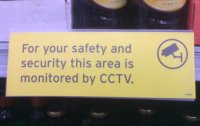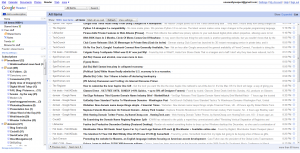 Regular readers will be aware that a fair proportion of my blog posts seem to have been inspired by trips to the local shops. It’s been a while though, so here’s another.
Regular readers will be aware that a fair proportion of my blog posts seem to have been inspired by trips to the local shops. It’s been a while though, so here’s another.
I was on a rare trip to the Sainsbury’s booze aisle yesterday when I spotted this sign.
I think it’s a good example of why businesses need to pay attention to all their copy.
The sign says: “For your safety and security this area is monitored by CCTV”. What’s wrong with it? Quite simply, I don’t think it’s open enough, and I don’t think it does anything to strengthen the Sainsbury’s brand.
Tell the truth
This sign is, admittedly, a small detail when compared to the Sainsbury’s website, TV adverts or even the more prominent signs in the store. But these details count.
A business as big as Sainsbury’s has thousands of these small pieces of text – on signs and in leaflets, online and in stores. By itself, each is a tiny thing. But together, their impact on people’s perception of the brand can be significant.
And even if the overall effect is neutral, they’re still missing a trick; each of these less-significant bits of copy is a chance to reinforce the values the company wants to communicate to its customers.
I think this particular sign is misleading too. Sainsbury’s doesn’t have cameras covering its beer, wine and spirits for the protection of customers. It’s for the protection of its revenue. I think they should be straight, and just admit that.
Want to be seen as a fun, company? Then try: “You’re on CCTV. It’s there to catch thieves, but we don’t mind if you want to pretend you’re on the telly too.”
Looking to be professional, but not too impersonal? How about: “This aisle is covered by CCTV. It helps us prevent theft – and that keeps our costs down, allowing us to sell you cheaper food.”
I think maybe that second approach would be a good one for Sainsbury’s. It admits that the CCTV is there to stop people nicking vodka. But it also explains the direct benefit to the customer: by reducing theft, the company is reducing the cost of losses which get passed to its customers. Everyone wins. And the customers know about it.
Finally, it communicates everything in a friendly, down-to-earth and (crucially) honest way. It’s turned a dull sign into a positive piece of branding for the store.
Everything counts
See, this is the thing. If you want to create a great brand, you have to think about your values every single time you communicate with customers.
Focusing on the big headlines and neglecting the areas which seem less important is a mistake. It’s like making your shop look amazing from the outside, but then never bothering to clean inside or arrange the products properly on the shelves.
(As an aside, the first thing Sainsbury’s should do is decide if a CCTV sign is worth having at all. Does it cut theft? If not, they should get rid of it, so customers spend less time wondering where the cameras are, and more time wondering which wine to buy.)
I started using Twitter a few months ago. If you haven’t encountered it yet, it’s a kind of micro-blogging tool which lets you post updates about what you’re doing. Each update takes a similar form to Facebook‘s “John is…” function, and you’re limited to 160 characters, so it’s a bit like sending a text message.
You can see my latest update in the right column of this blog, or see my stream of tweets (that’s what the little updates are called) over on my Twitter homepage. Once you’re a member, you can follow other Twitter members. When you follow someone, all their tweets appear in your Twitter stream.
Frankly, it’s not immediately obvious what Twitter is for. As a copywriter, I joined without a good idea of why I was joining it or what I’d use it for. I mainly just wanted to work out what the hell it was all about: it’s not the easiest of things to get your head around, and the best way to work it out is to try it.
But since I started using it, it’s become clear there’s a lot more to Twitter than meets the eye. It’s not just a way to let your mates know you’re just back from the shops or down the pub. It’s a seriously useful tool that can help you in all kinds of ways.
I’d definitely recommend you get over to Twitter and sign up for an account now. But if you need some persuading, here are six things I’ve found it useful for:
Finding useful contacts. It can be a networking tool, basically. Whether you’re a web copywriter, like me, or in a completely different line of work, you can make some great connections on Twitter. One of the best ways is to take a look at the people you follow, and see who they follow. If anyone looks interesting, follow them too. Because most tweets are public, it’s fine to follow whoever you like.
Keeping in touch with your mates. I’ve all but given up on Facebook. I never entirely got the hang of it, and these days I find if I log in I just get overwhelmed with information. The most interesting bit is following friends’ status updates. And Twitter lets me do that, without all the other spurious stuff that’s part of Facebook. Of course, you’ll need to persuade your mates to join too.
Getting answers fast. If you have enough followers, Twitter becomes a bit like one of those services where you can text any question and receive an almost instant response. For instance, before a recent trip to Berlin, I tweeted asking for recommendations. Within a few minutes, I’d discovered that one of my followers had edited a guidebook of the city. Result!
Connecting with celebrities. When I discovered national institution Stephen Fry was on Twitter, I thought it was absolutely fantastic. Because it’s so obviously him tweeting, you get a direct connection to someone you only usually see on TV. Not sure how he deals with the massive number of direct messages he must get though. Apparently Britney’s on Twitter too, though it looks like a rather sanitised, PR-driven effort rather than Britney tapping away at a keyboard for herself.
Keeping up with the news. I’m not going to claim that Twitter is a useful tool for in-depth journalism and analysis of current affairs. But it’s great for getting eyewitness snapshots of events as they unfold. For example, there was an explosion on Slough Trading Estate the other week. I used to work there, so was interested in what was going on. Local news sites weren’t reporting anything, but by searching Twitter I found someone who was there as it happened. And just yesterday, one guy tweeted from a plane crash. Yes, really.
Venting your frustrations. I’m not sure how much my followers appreciate it, but I’ve vented at the terrible train service offered by First Great Western more than once. With Twitterific on my iPhone I can tweet from anywhere, and it makes me feel a little less helpless when I find myself awaiting a delayed train yet again. Try it sometime. It really does make you feel better.
There are plenty of other ways to use Twitter, and plenty of other reasons to use it. So if you haven’t given it a go yet, hop on over and sign up. You can tweet directly from the website, or use one of the many web-based and mobile phone clients to make it easier.
And if you don’t mind the occasional train-related rant, do add me once you’ve signed up. I’ll be sure to return the favour.
I use Google Reader. A lot. It’s my main source of news and information through the day, and I find it’s great for homing in on stories I’m interested from websites I like.
I logged in a few minutes ago and it’s been redesigned. I haven’t explored the new interface fully yet, but it looks cleaner. They don’t seem to have added any themes (like they did with Gmail), but at first glance it looks good.
Judge for yourself with this screenshot. Click for full-size:

Do you rely on a good RSS Reader for news? Which is your favourite? Leave a comment and let me know.
 Regular readers will be aware that a fair proportion of my blog posts seem to have been inspired by trips to the local shops. It’s been a while though, so here’s another.
Regular readers will be aware that a fair proportion of my blog posts seem to have been inspired by trips to the local shops. It’s been a while though, so here’s another.
